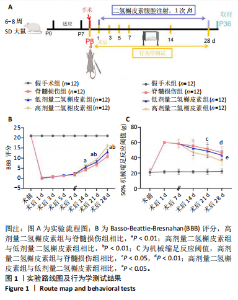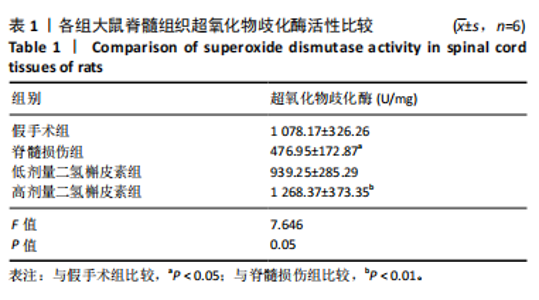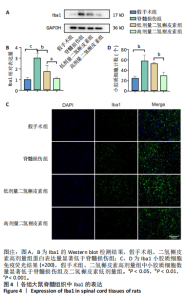[1] MAHANES D, MUEHLSCHLEGEL S, WARTENBERG KE, et al. Guidelines for neuroprognostication in adults with traumatic spinal cord injury. Neurocrit Care. 2024;40(2):415-437.
[2] TRAN AP, WARREN PM, SILVER J. The Biology of Regeneration Failure and Success After Spinal Cord Injury. Physiol Rev. 2018;98(2):881-917.
[3] LI X, LI M, TIAN L, et al. Reactive Astrogliosis: Implications in Spinal Cord Injury Progression and Therapy. Oxid Med Cell Longev. 2020;2020: 9494352.
[4] COFANO F, BOIDO M, MONTICELLI M, et al. Mesenchymal Stem Cells for Spinal Cord Injury: Current Options, Limitations, and Future of Cell Therapy. Int J Mol Sci. 2019;20(11):2698.
[5] GAOJIAN T, DINGFEI Q, LINWEI L, et al. Parthenolide promotes the repair of spinal cord injury by modulating M1/M2 polarization via the NF-kappaB and STAT 1/3 signaling pathway. Cell Death Discov. 2020; 6(1):97.
[6] LU X, LU F, YU J, et al. Gramine promotes functional recovery after spinal cord injury via ameliorating microglia activation. J Cell Mol Med. 2021;25(16):7980-7992.
[7] 田军军, 顾媛媛. 二氢槲皮素生物活性及作用机制最新研究进展[J]. 黑龙江科学,2022,13(18):5-8.
[8] INOUE T, SAITO S, TANAKA M, et al. Pleiotropic neuroprotective effects of taxifolin in cerebral amyloid angiopathy. Proc Natl Acad Sci U S A. 2019;116(20):10031-10038.
[9] ORLOVA SV, TATARINOV VV, NIKITINA EA, et al. Bioavailability and Safety of Dihydroquercetin (Review). Pharm Chem J. 2022;55(11):1133-1137.
[10] 吕瑾, 刘长召, 华晓芳, 等. 花旗松素在小鼠心肌肥厚及纤维化中的作用及机制研究[J]. 国际心血管病杂志,2020,47(6):360-365.
[11] LEI L, CHAI Y, LIN H, et al. Dihydroquercetin Activates AMPK/Nrf2/HO-1 Signaling in Macrophages and Attenuates Inflammation in LPS-Induced Endotoxemic Mice. Front Pharmacol. 2020;11:662.
[12] 王佳奇, 宋明铭, 陈凯, 等. 二氢槲皮素与二氢杨梅素的抗肿瘤活性对比[J]. 中国免疫学杂志,2016,32(11):1614-1620.
[13] 孙春梅, 唐玲, 庹玉平. 二氢槲皮素对心力衰竭大鼠心功能的保护作用及其作用机制[J]. 中西医结合心脑血管病杂志,2023,21(21): 3941-3947.
[14] 徐伟龙, 左媛, 辛大奇, 等. 急性钳夹型脊髓损伤模型大鼠造模方式的选择:一项网状Meta分析[J]. 中国组织工程研究,2021, 25(23):3767-3772.
[15] 吴杨鹏, 范筱, 张俐. 急性脊髓损伤动物模型的建立与评估[J]. 中国组织工程研究,2016,20(49):7341-7348.
[16] 陈星月, 陈栋, 陈春慧, 等. 中国创伤性脊髓损伤流行病学和疾病经济负担的系统评价[J]. 中国循证医学杂志,2018,18(2):143-150.
[17] 易超然. 湖南省261例脊髓损伤住院患者流行病学调查分析[D].衡阳: 南华大学,2015.
[18] 杨永栋, 赵赫, 俞兴, 等. 脊髓损伤后继发性损伤的相关信号通路[J]. 中国组织工程研究,2017,21(32):5227-5233.
[19] PARK J. Immunomodulatory Strategies for Spinal Cord Injury. Biomed J Sci Tech Res. 2022;45(3):36467-36470.
[20] FAN B, WEI Z, YAO X, et al. Microenvironment Imbalance of Spinal Cord Injury. Cell Transplant. 2018;27(6):853-866.
[21] 郑鹏, 刘宇, 李学鹏, 等. 甲强龙抑制大鼠脊髓损伤后小胶质细胞活化介导炎症的作用机制[J]. 中华实验外科杂志,2019,36(2):372.
[22] BRENNAN FH, LI Y, WANG C, et al. Microglia coordinate cellular interactions during spinal cord repair in mice. Nat Commun. 2022; 13(1):4096.
[23] 杨文洁, 王珺楠, 孙涛. 巨噬细胞/小胶质细胞极化在脊髓损伤后神经病理性疼痛中的作用机制:文献综述[J]. 中华疼痛学杂志, 2023,19(2):342-347.
[24] 付海涛, 戚超, 陈进利, 等. 小神经胶质细胞去除联合骨髓间质干细胞移植修复小鼠脊髓损伤的实验研究[J]. 中华骨科杂志,2021, 41(24):1803-1812.
[25] BELLVER-LANDETE V, BRETHEAU F, MAILHOT B, et al. Microglia are an essential component of the neuroprotective scar that forms after spinal cord injury. Nat Commun. 2019;10(1):518.
[26] 逄弓一郎, 卓小玉, 刘玉婷, 等. 星点设计-效应面法优化二氢槲皮素提取工艺[J]. 化学工程师,2021,35(2):10-13,16.
[27] SUNIL C, XU B. An insight into the health-promoting effects of taxifolin (dihydroquercetin). Phytochemistry. 2019;166:112066.
[28] ORLOVA SV, TATARINOV VV, NIKITINA EA, et al. Bioavailability and Safety of Dihydroquercetin (Review). Pharm Chem J. 2022;55(11):1133-1137.
[29] 董潞娜, 曹浩, 张欣宇, 等. 二氢槲皮素的研究进展[J]. 生物技术进展,2020,10(3):226-233.
[30] 李晓贤. 二氢槲皮素通过激活小胶质细胞TREM2减轻LPS诱导的多巴胺能神经元损伤[D]. 遵义: 遵义医科大学,2022.
[31] 顾媛媛, 姜波, 刘旭, 等. 二氢槲皮素对脑缺血损伤模型大鼠炎症因子、氧化应激水平以及脑组织能量代谢影响[J]. 辽宁中医药大学学报,2019,21(6):36-38.
[32] 罗玲艳, 杜昆. IL-10通过上调socs3抑制衣原体感染细胞炎症因子表达[J]. 中国免疫学杂志,2024,40(3):530-533.
[33] 章德文, 丁娴, 王睿, 等. IL-6/IL-10指数在脓毒症虚实辨证中的临床价值观察[J]. 中国中医急症,2023,32(7):1227-1230.
[34] 卫金凤, 杨章, 郭鹏. P38 MAPK/NF-κB/NLRP3对脑卒中大鼠模型对神经元的影响[J]. 脑与神经疾病杂志,2024,32(7):401-405.
[35] MORENO-CUGNON L, ARRIZABALAGA O, LLARENA I, et al. Elevated p38MAPK activity promotes neural stem cell aging. Aging (Albany NY). 2020;12(7):6030-6036.
[36] 孙洋, 许轶博, 肖林雨, 等. 乙酰紫堇灵促进大鼠脊髓损伤后的功能恢复:基于调控EGFR/MAPK信号通路抑制小胶质细胞活化[J]. 南方医科大学学报,2023,43(6):915-923.
[37] 董博, 李越, 李迎春, 等. 吡拉西坦通过MAPK通路治疗大鼠脊髓损伤的疗效观察与机制研究[J].中国骨伤,2024,37(6):591-598. |











